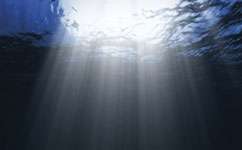Deep-sea diversity surprises researchers

Scientists have shed new light on the evolution of deep-sea creatures by looking at the genes of one shrimp-like species, rather than their physical characteristics.
Working in the seas around New Zealand, the scientists concentrated on a closely-related group of species, known as a genus, called Rhachotropis. They found a new species and made fundamental discoveries about the family's origins – it turns out that not all New Zealand members descend from a common ancestor.
"In the science field I'm in, finding a new species is quite regular," explains Dr. Katrin Linse of the British Antarctic Survey, one of the international team behind the paper, which appears in PLoS ONE. "We're going to areas where noone has ever looked before."
This is the first time scientists have looked at the shrimp-like group's genes rather than at its physical features to try to trace its members' evolutionary relationships. The team found more difference between the species than they expected, providing a snapshot of the Rhachotropis 'family tree' that suggests many more species are still to be discovered.
The researchers even found a new species, which they have named Rhachotropis novazealandica after the study area. It's the fifth new member of the family in the Southern Hemisphere to turn up in two years.
More of a surprise were the wider discoveries about the evolutionary history of the genus. It turns out that Rhachotropis species around New Zealand do not all have a common ancestor. The creatures living in the middle depths of the ocean are more closely related to those on the other side of the world, in the Arctic, than to their neighbours deeper below them.
"This is a different pattern to what we expected," say the research team, which was led by Anne Nina Lörz of the New Zealand National Institute of Water and Atmospheric Research.
Previous studies have only looked at the animals' outer features. This time, the scientists looked at DNA. Combining the two methods gives more information.
The researchers are interested in Rhachotropis because it lives almost everywhere, from the poles to the tropics and from shallow coastal waters to the deep sea. They hope studying DNA will let us understand how deep sea creatures spread and adapted to their new habitats, and the incredible distribution of Rhachotropis makes this an ideal genus to study.
It seems that for this group of species, depth, rather than geographical distance, determines how closely related species are. The discovery of such closely-related species in the deep sea at other sides of the world suggests that Rhachotropis started out as a deep-sea group that then moved up to the shallows.
"There could be similar patterns elsewhere," Linse points out, making it clear that there is more to discover about the deep. "Rhachotropis is an excellent example."
The Rhachotropis group is related to shrimps and prawns, but its members are a lot smaller. The new species is just 17mm long. Even so, physical features such as mouthparts, antenna and leg sections can be used to distinguish between species using a microscope.
Despite their tiny size, the first few species were identified in the 18th century. Of the 60 species that have been identified since, most live in shallow waters. This is probably not because there are fewer species in the deep, but because the deep-sea specimens are harder to sample.
80 per cent of the world's ocean is deep sea – cold, dark, deep and unexplored. "There's plenty more work to be done," points out Linse. "We know more about the moon than we do about the deep sea."
More information: Lörz A-N, Linse K, Smith PJ, Steinke D (2012) First Molecular Evidence for Underestimated Biodiversity of Rhachotropis (Crustacea, Amphipoda), with Description of a New Species. PLoS ONE 7(3): e32365. doi:10.1371/journal.pone.0032365
Journal information: PLoS ONE
Provided by PlanetEarth Online
This story is republished courtesy of Planet Earth online, a free, companion website to the award-winning magazine Planet Earth published and funded by the Natural Environment Research Council (NERC).















